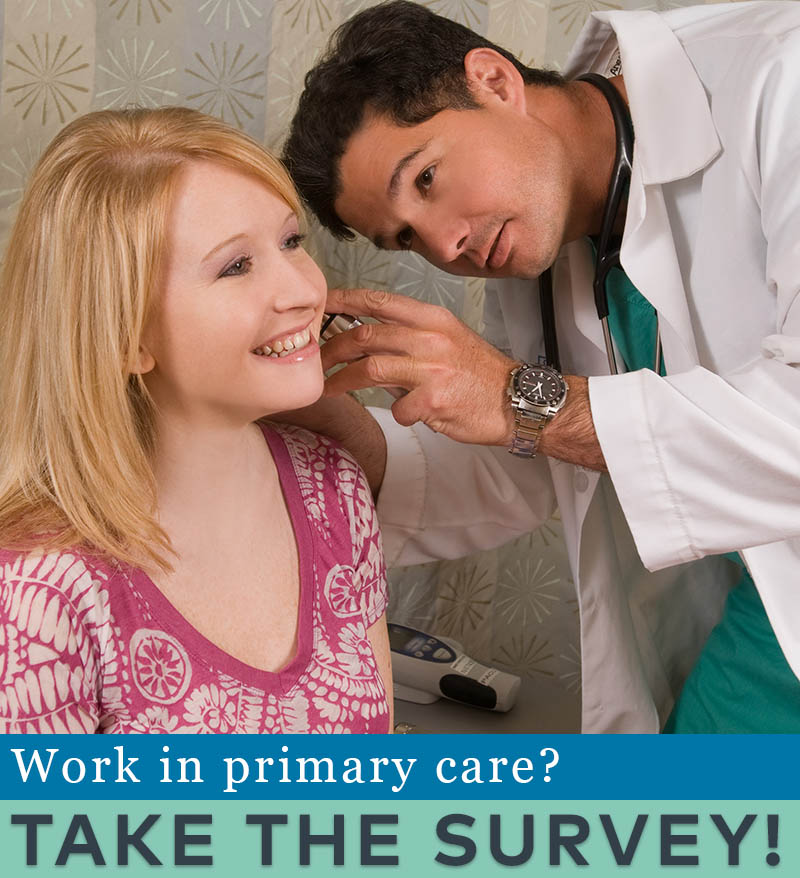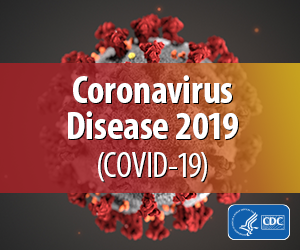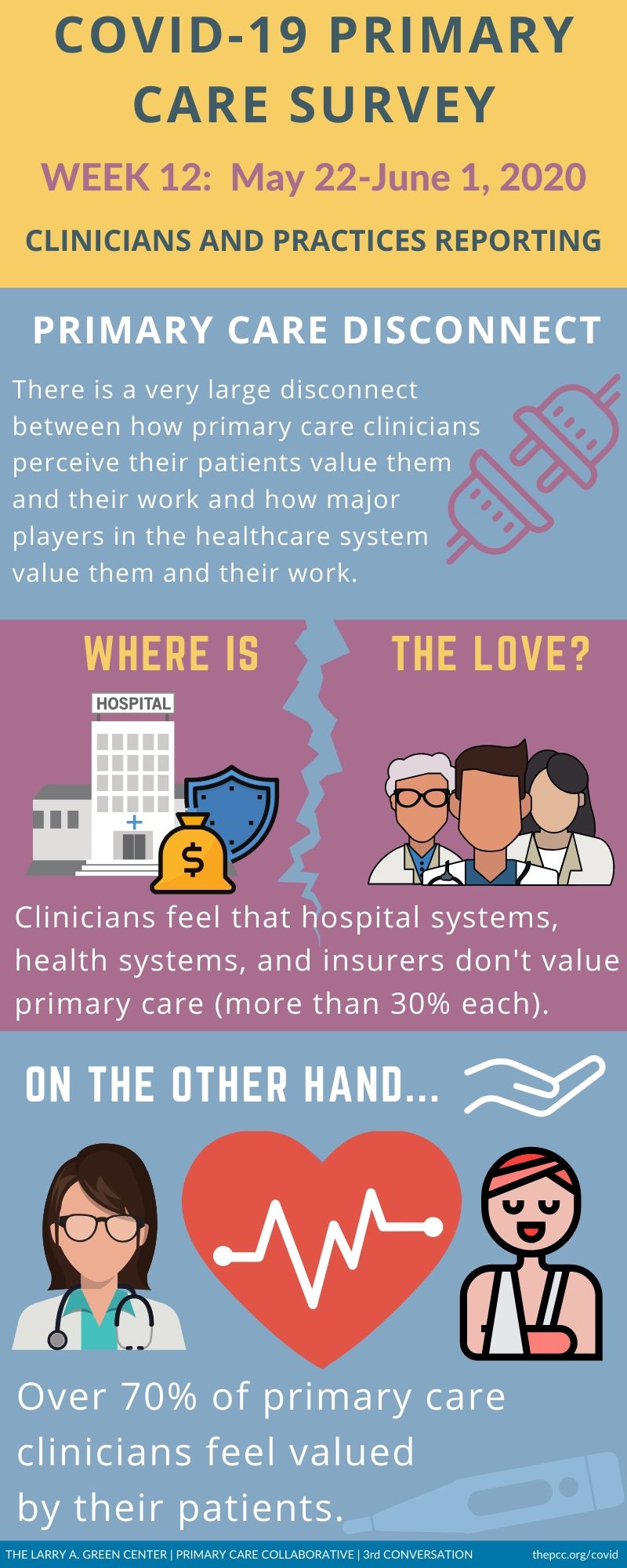You are looking at an archived version of our site. Please visit thepcc.org for a fresh, new experience!
You are here: Array » Primary Care & COV ...
Primary Care & COVID-19: Week 12 Survey
Check back weekly for the latest survey results and updates.
For last week's data, see Week 11 Results.
Who replied to the survey in Week 12?
A primary care clinician survey (weekly), and a patient survey (generally every other week) are being fielded by the Larry A. Green Center in partnership with the Primary Care Collaborative and 3rd Conversation. Both surveys are anonymous and voluntary, using national convenience samples to better understand the impact of COVID-19 on primary care from two important vantage points.
The week 12 clinician survey was fielded May 29-June 1 and received 558 responses from clinicians in 47 states and Washington, D.C., with 68% of practices identifying as family medicine, 17% as internal medicine, 6% as pediatrics, 5% as geriatrics, and 5% as other. Slightly more than 23% of the practices self-described as rural, 14% as community health centers, and 27% have a patient-centered primary care medical home designation. Approximately one-third practice in very small practices of 1-3 clinicians, and one-third of respondents own their practice.
The week 2 patient survey was fielded May 4-11 and received 2,250 respondents of diverse education (34% high school degree, 47% college degree, 15% graduate degree); income (44% less than $50,000 household income, 7% greater than $150,000 household income); and geographies (30% urban and 21% rural). One-third were 18-35 years old, one-third were over 50. Level of health varied, with 36% rating their health as very good and 30% saying good. 46% were male, 52% female; 42% were employed full-time, and 14% were employed part-time. 20% lost employment during the pandemic.
Results at a glance
Stress on primary care persists: On a scale of 1-5, over 69% of practices report a level of strain of 4 or higher. Some of the major stressors are patients limiting their chronic and well visits (80%), the practice limiting chronic and well visits (61%), and parents delaying well child visits (52%).
The proportion of practices reporting a majority visits happening in person has rebounded to 35%, with about 30% reporting either mostly video or telephonic care as the most frequent mode of delivery. However, over 80% report that patients struggle with virtual care, and 21% have had telehealth claims denied.
While 53% of practices report some capacity to test patients for COVID-19, 25% report having no current capacity to test at this point in the pandemic. In addition, 52% report PPE shortages, making testing and triaging potential COVID-19 patients challenging.
Assessing the appropriateness of virtual care: Most primary care clinicians now have experience delivering care via phone and video visits. The survey probed how well-suited these modes are for providing various types of care.
Video outperforms phone for suitability for all primary care visit types. Clinicians report that mental and behavioral health are the most well-suited for video visits (over 90% report well-suited), with adult stable chronic and preventive visits also well-suited for video (88% and 68% respectively). Injuries and non-stable chronic visits, well child visits, and developmental assessments are considered least suitable for both phone and video visits.
Other types of visits considered “well-suited” for video by at least 70% of respondents include addiction, chronic pain, medication reconciliation, paperwork, worried well with COVID-19 concerns, care transitions, and cancer and/or survivor care. The suitability of phone-only fell for all of these types of visits, with the biggest drops in suitability identified for addiction care and chronic pain care, with both still considered well-suited by a slight majority of respondents.
Primary care feels more valued by patients than by the health care system and payers: There is a very large “disconnect” between how primary care clinicians perceive their patients value them and their work and how major players in the health care system value them and their work. On the positive side, over 70% of primary care clinicians feel valued by their patients, but less than 20% feel valued by hospital systems, and barely 20% feel valued by specialists. Primary care clinicians feel more valued by employers (27% perceive they are valued) than by private insurers (10%).
Learn more: Download
Both include select open-ended answers to survey questions.
Voices from the Primary Care Front Lines
Both patients and physicians see value in virtual care.
Patients:
“I like the phone visit stuff. I would like to never have to go to the office again.”
I think it is a wonderful thing to have a virtual visit with your doctor. It can be very comforting at this time.”
Clinicians:
“We have managed COVID-19 by phone and video and e-portal and only referred when necessary.” (New York)
“I think that there is an emerging complex balance between when video is essential and ‘nice to have’. Insisting on video is a huge equity issue for patients.” (Massachusetts)
Practices remain under strain, under-resourced.
Clinicians:
“We’re interested in doing testing but we don’t have PPE.” (Nevada)
“I am dismayed by the lack of prompt response from private insurers to give parity for phone and video or any prospective payment, not a loan, which would help the survival of independent practice.” (Texas)
Mental stress from social isolation, economic worries are real.
Patients:
“I miss visiting my friends and family.”
“Mental health support should be available to everyone once pandemic is over.”
“Still waiting on my stimulus check and serious issues with my living conditions. Feeling depressed and doomed lately.”
Clinicians:
“All of my patients are under duress which is causing worsened conditions as well as new onset illnesses. I spend my day counseling everyone as well as trying to help their pain and suffering.” (Texas)
“Primary care remains in a world of hurt, and those of us who were lucky enough to survive the initial onslaught will not survive the next wave.” (Virginia)
“I feel burned out.” (Pennsylvania)
| Attachment | Size |
|---|---|
| 730.2 KB | |
| 121.94 KB | |
| 117.64 KB | |
| 470.74 KB |

Are you a physician, nurse practitioner, or PA working in primary care?
Help PCC and the Larry A. Green Center track how your practice is responding to the COVID-19 outbreak by completing the Green Center's occasional survey.
The regular surveys are no longer being conducted.
COVID-19 Updates
February 10, 2022 | JAMA Network
January 26, 2022
December 17, 2021
December 14, 2021 | Primary Care Collaborative
December 10, 2021 | The Commonwealth Fund
- ‹ previous
- 2 of 39
- next ›
Recent News
August 16, 2024
August 12, 2024
July 16, 2024
Missed our May webinar, “The Commercial Market: Alternative Payment Models for Primary Care,” check out this clip!… https://t.co/mDZH3IINXK —
2 years 5 months ago
Did you catch @CMSinnovates' new #primarycare strategy? Thanks to concerted efforts from @NAACOSnews and other memb… https://t.co/mDnawqw8YW —
2 years 5 months ago
Not up to date on the #Medicaid Access and #Managedcare proposed rules important for #primarycare? No worries,… https://t.co/qB6sY3XCZ1 —
2 years 5 months ago
Secondary menu
Copyright © 2024 Primary Care Collaborative





